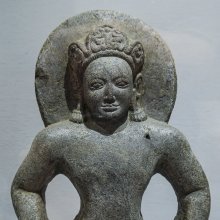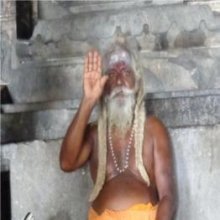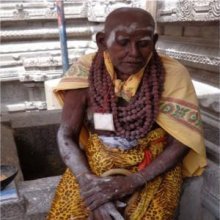Addressing: 2 definitions
Introduction:
Addressing means something in Hinduism, Sanskrit. If you want to know the exact meaning, history, etymology or English translation of this term then check out the descriptions on this page. Add your comment or reference to a book if you want to contribute to this summary article.
Images (photo gallery)
In Hinduism
Purana and Itihasa (epic history)
Source: Shodhganga: Elements of Art and Architecture in the Trtiyakhanda of the VisnudharmottarapuranaAddressing spells (and charms, auspicious and bad signs etc.) was traditionally considered a form of art, as part of the “sixty four kinds of Art”, according to the Kamasutra of Vatsyayana.—Cf the Sanskrit Nimittajñāna.—Indian tradition, basically includes sixty four Art forms are acknowledged. The history of Indian Art covers approximately five thousand years which presents a rich and almost continuous record. The references of sixty four kinds of Kala (कला, kalā) are found in the Bhagavatapurana, Shaiva-Tantras, Kamasutra of Vatsyayana etc.

The Purana (पुराण, purāṇas) refers to Sanskrit literature preserving ancient India’s vast cultural history, including historical legends, religious ceremonies, various arts and sciences. The eighteen mahapuranas total over 400,000 shlokas (metrical couplets) and date to at least several centuries BCE.
Natyashastra (theatrics and dramaturgy)
Source: Shodhganga: Elements of Art and Architecture in the Trtiyakhanda of the Visnudharmottarapurana (natya)Addressing (teachers) is associated with Kapota-hasta: one of the thirteen Combined-hand Gestures (in Indian Dramas) (known as saṃyuktahastas), according to the Viṣṇudharmottarapurāṇa, an ancient Sanskrit text which (being encyclopedic in nature) deals with a variety of cultural topics such as arts, architecture, music, grammar and astronomy.—The word kapota means pigeon in Sanskrit. When the sides of two hands are joined together it is looked like a pigeon with its wings. In the Viṣṇudharmottarapurāṇa this hand posture is called as kapotahasta and it is used to show cold and danger. But in the Abhinayadarpaṇa, this posture is said to use in salutation, addressing teachers, polite acceptance or agreement.

Natyashastra (नाट्यशास्त्र, nāṭyaśāstra) refers to both the ancient Indian tradition (shastra) of performing arts, (natya—theatrics, drama, dance, music), as well as the name of a Sanskrit work dealing with these subjects. It also teaches the rules for composing Dramatic plays (nataka), construction and performance of Theater, and Poetic works (kavya).
See also (Relevant definitions)
Full-text (+373): Abhibhashin, Amantrana, Sambodhana, Abhibhasana, Pratyabhibhashin, Tvamkara, Namagraha, Hanje, Au, Samudacarin, Asmatapana, Hala, Abhimukhikarana, Bhagavati, Abhashana, Abhimantrana, Alapa, Bhattini, Amantana, Appaji.
Relevant text
Search found 179 books and stories containing Addressing; (plurals include: Addressings). You can also click to the full overview containing English textual excerpts. Below are direct links for the most relevant articles:
Natyashastra (English) (by Bharata-muni)
Chapter XIX - Modes of Address (nāman) and Intonation (kāku)
Chapter XXVI - Varied Representation (citrābhinaya)
Part 8 - The Date of the Nāṭyaśāstra < [Introduction, part 1]
Shaiva Upanishads (A Critical Study) (by Arpita Chakraborty)
11. The Taittirīya Upaniṣad glorifies on “OM” < [Chapter 2 - “Om” and its Esoteric Significance]
13. Chāndogya Upaniṣad and Udgītopāsana on ‘OM’ (Aum) < [Chapter 2 - “Om” and its Esoteric Significance]
Bihar and Eastern Uttar Pradesh (early history) (by Prakash Narayan)
The Buddha and the Brahmanas in the Buddhist view < [Chapter 4 - Social Process, Structures and Reformations]
Monks and Extended Kin-groups < [Chapter 4 - Social Process, Structures and Reformations]
Monks and Brahmanas < [Chapter 4 - Social Process, Structures and Reformations]
Dramaturgy in the Venisamhara (by Debi Prasad Namasudra)
Description of Ākāśabhāṣita < [Chapter 4 - Dramaturgy in Veṇīsaṃhāra]
Modes of Addess in a Drama < [Chapter 4 - Dramaturgy in Veṇīsaṃhāra]
Rig Veda (translation and commentary) (by H. H. Wilson)
Brihad Bhagavatamrita (commentary) (by Śrī Śrīmad Bhaktivedānta Nārāyana Gosvāmī Mahārāja)
Verse 1.5.110 < [Chapter 5 - Priya (the beloved devotees)]
Verse 2.3.55 < [Chapter 3 - Bhajana (loving service)]
Verse 1.6.103 < [Chapter 6 - Priyatama (the most beloved devotees)]



